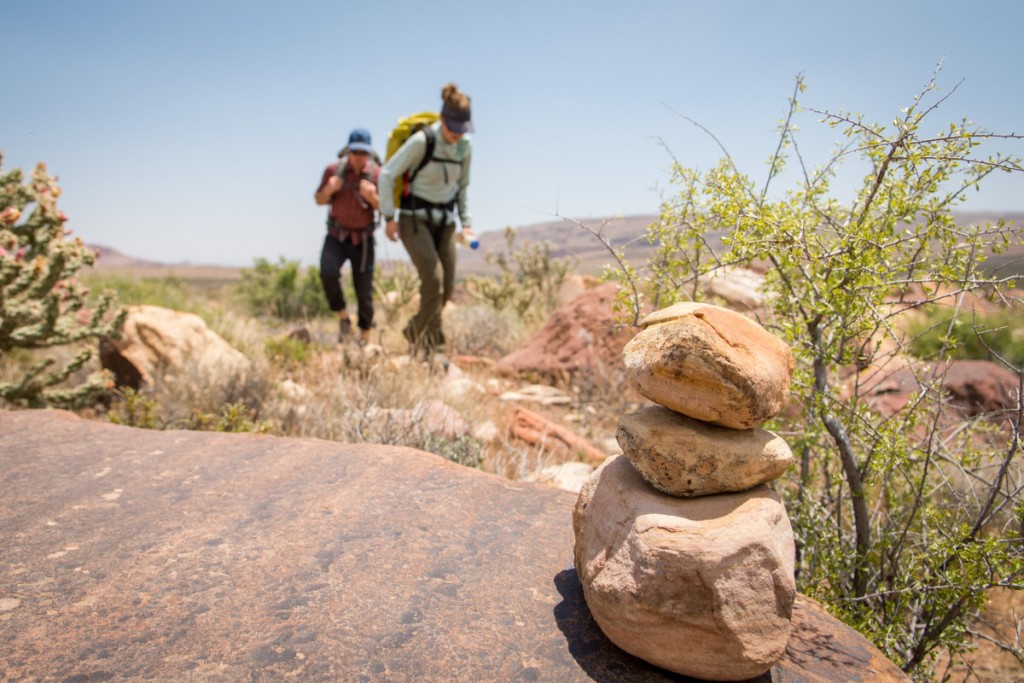 Climbing the Birdland route. Photo courtesy of Kathryn Martin.
Climbing the Birdland route. Photo courtesy of Kathryn Martin.
By Kathryn Martin, NOLS instructor
Flying into a new city at night is always a little disorienting. Flying into the flashy, light- filled Las Vegas airport for a wilderness climbing trip? That is something else entirely.
I was flying into the Vegas airport to meet my partner, Logan, for a 10-day climbing trip. Red Rock Canyon National Conservation Area is less than 10 miles outside of the greater Las Vegas city limits. It is known in climbing communities to be a mecca for single and multi-pitch sport and traditional protected climbing. Red Rocks is also a common location for NOLS climbing courses, as it has many moderate single and multi-pitch routes.
We wanted to see what all the fuss was about.
The intention of this climbing trip was three fold. First, I wanted to continue to develop my traditional rock climbing and rescue system skills to fulfill the qualifications to be assessed as a NOLS climbing instructor. Second, we wanted to preview the introductory and moderate routes NOLS students often use in Red Rocks to better prepare ourselves to lead students on these routes. Third, Logan was excited to practice his mentorship of instructors and coaching of students, as well as explore a new climbing area.
We spent our days practicing anchor building and top rope set-up, scouting out good single pitch climbing crags, climbing moderate multi-pitch routes, and practicing rescue skills, including haul systems, lowers, and complex rappels.
Throughout this climbing trip I was very physically reminded of the value of tolerance for adversity and uncertainty, one of the seven leadership skills students learn on NOLS courses.
This was especially evident during my “graduation day multi-pitch.” We had decided I would lead all pitches to practice single leader systems and manage Logan as a student.
As I got set up to lead the third pitch, we (I) didn’t realize how wandering the route would be. After placing the first few pieces of protection, I rounded a corner. It felt like I was dragging a small elephant between my legs. Before making the next move, I would have to pull up a little slack in the rope. The drag on the rope was pretty bad, but I couldn’t figure out what was causing it.
Feeling confident on the terrain, but uncertain as to where my anchors were, I slowly continued up the pitch. During one of my pauses, consulting my topo map for landmarks or direction, I spotted a little metal down past my left foot. I craned my head for a better view. Of course, there it was! That dang bolted anchor!
Realizing my predicament, I softly swore. I knew I had a few options. I could build an anchor where I was, or continue up the pitch (with the hope of finding the final set of bolted anchors), or down-climb to the mischievous anchor. Being uncertain of where or what was causing my rope drag (and fearing it would get worse if I found myself in more challenging terrain), I began to down climb, removing protection pieces as I went. When I was level with the bolted anchors, I traversed over. After securing myself on the anchor, I began to pull up the rope to bring my partner onto belay.
Sweating, hungry, frustrated and feeling sorry for myself, I pulled up that rope foot by foot. And it was the most challenging 80 feet of rope I have ever pulled. As my partner climbed, I realized I needed to pull myself together. As we ate food, drank water, and laughed about my struggles, I felt my energy returning.
 Kathryn (right) and Logan (left). Photo by Kathryn Martin.
Kathryn (right) and Logan (left). Photo by Kathryn Martin.
From this experience I was very physically reminded about the potential challenges and adversities one can have while multi-pitch climbing. I also increased my ability to recognize climbing risks and manage them appropriately. You may not be able to find the next set of anchors, you may have climbed past where you want to be, you might have excessive rope drag (even though you tried "oh so hard" to prevent it), you may be sweating profusely, you may be hangry, you may have a challenging rappel or descent, and you may have still more decisions to make or challenges and risk to manage. And it will be okay.
These learnings in tolerance for adversity and uncertainty were important for me as an instructor, as I can pass them on to future students.
Logan and I also found time for non-climbing adventures. One evening, we wandered into downtown Vegas to take in the full city experience.
 Las Vegas lights. Photo by Kathryn Martin.
Las Vegas lights. Photo by Kathryn Martin.
After absorbing the neon lights on the strip, being dazzled by the many local and tourist personas, and filling our hungry bellies with some delicious street tacos, we saw a Cirque du Soleil show. While being mesmerized by the gravity-defying aerobatics, we found ourselves constantly analyzing the physics of the safety systems Cirque uses to keep their aerialists safe 90-plus feet above the stage. Maybe all those rescue system practices had been making more of an impact than we realized!
After this trip, I was able to take the NOLS Rock Climbing Seminar at the Southwest campus just outside of Tucson, Arizona and was assessed to instruct climbing courses for NOLS. Thanks to the NOLS Instructor Development Fund, my time in Red Rocks prepared me for this seminar and for working climbing courses in Red Rocks to facilitate excellent student experiences.
About the Author: Kathryn is a NOLS backpacking and climbing instructor who runs far distances and works as an EMT. She doesn’t drink coffee. Logan is a NOLS climbing, hiking, canyon, winter, and wilderness medicine instructor. Recently, he has begun sewing his own lightweight backpacking gear.
Calling all Rock Climbing Enthusiasts!
Unleash your passion for multi-pitch climbing with NOLS Rock Climbing Courses. Our courses are designed to elevate your expertise while immersing you in the beauty of iconic climbing destinations. Don't miss this chance to scale new heights and forge lifelong connections.




 Making the approach. Photo by Jared Steinman.
Making the approach. Photo by Jared Steinman.